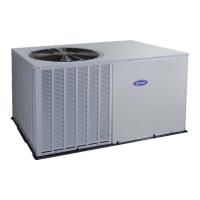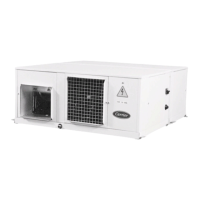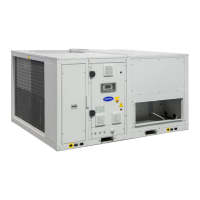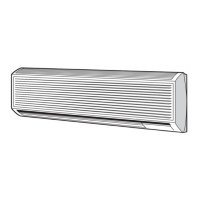: Service Manual
Manufacturer reserves the right to change, at any time, specifications and designs without notice and without obligations.
26
indoor temperature is between 70°F and 80°F (21.11°C and 26.67°C).
Follow the procedure below:
To check charge allow system to operate in cooling mode at least 15
minutes. If conditions are favorable, check system charge by subcooling
method. If any adjustment is necessary, adjust charge slowly and allow
system to operate for 15 minutes to stabilize before declaring a properly
charged system.
If the indoor temperature is above 80°F (26.67°C), and the outdoor
temperature is in the favorable range, adjust system charge and allow the
indoor temperature to drop to 80°F (26.67°C) before attempting to check
system charge by subcooling method as described above.
If the indoor temperature is below 70°F (21.11°C), or the outdoor
temperature is not in the favorable range, the charge level could then be
checked at another time when the both indoor and outdoor temperatures
are in a more favorable range.
Troubleshooting with SuperHeat
This troubleshooting routine was developed to diagnose cooling
problems using superheat in TXV systems. It is effective on heat pumps
in cooling mode as well as air conditioners. The system must utilize a
TXV as the expansion device in cooling mode.
Basic Diagnostics
NOTE: When checking refrigerant charge and troubleshooting
operating systems, the indoor airflow has significant effect on the
determination. If you are at this stage, it is assumed you have already
checked the subcooling once and believe the charge is correct. From this
point, the airflow must be verified prior to proceeding, hence Step 1
below.
1. Check or verify proper indoor airflow
• Indoor air filter
• Duct dampers and supply registers are open
• Indoor coil for debris
2. Check subcooling at OD coil and discharge high flow valve
• Outdoor airflow (debris on coil, etc.)
• Set the subcooling at value listed on rating plate.
3. Check superheat at suction high flow service valve.
• If low (< 2°F), proceed to Low SuperHeat section.
• If between 2 and 20°F/-6.7_C valve is probably operating
properly.
• If operation erratic (hunting), proceed to Hunting Superheat °F
Superheat in repetition section.
NOTE: Hunting is when the valve superheat swings more than 10_.
Low Superheat with Normal or Low Suction Pressure
NOTE: Normal or low suction pressure is considered for R-410A: < 135
psig
1. Re-check airflow and then check sensing bulb tightness,
orientation on vapor tube and is properly wrapped.
• Low Superheat with Normal or Low Suction PressureIf OK
proceed to Step 2
2. Check superheat at suction high flow service valve and Pseudo
Evaporator Superheat.
• If both are less than 2°F, TXV likely not controlling properly, i.e.
stuck open -> REPLACE VALVE
• If superheat is higher than 15°F, proceed to Step 3
3. Perform TXV function check.
• With system running, place sensing bulb in ice bath for ~1
minute -> superheat should increase.
– If no response, Replace Valve
– If OK proceed to Step 4
4. Check for even temperature distribution at outlet of each circuit of
evaporator
• If greater than 15°F between circuits, distributor or coil has a
restriction.
• If OK proceed to Step 1
Low Superheat with High Suction Pressure
NOTE: High suction pressure is considered for R-410A: > ~135 psig.
Component failure typically causes this condition.
1. Check airflow, sensing bulb tightness, orientation on vapor tube
and ensure bulb is properly wrapped.
• If OK proceed to Step 2
2. Check that compressor is pumping properly
NOTE: Loose Rules of Thumb: Is discharge saturated ~20°F higher
than ambient temperature? Is discharge superheat between 15 and 50?
• If OK proceed to Step 3
3. Recheck Airflow and Subcooling.
• If OK proceed to Replace Valve
High Superheat with Normal or Low Pressure
NOTE: Normal or low suction pressure is considered:
R-410A < 135 psig.
1. Check for restriction in liquid line (kinked line, filter drier
restricted, etc.)
• If OK proceed to Step 2
2. Check for restriction in suction line (kink, restricted suction filter
drier etc.)
• If OK proceed to Step 3
3. Check power element cap tube is not broken
• If OK proceed to Step 4
4. Check that equalizer tube is not kinked or plugged
• If OK proceed to Step 5
5. Check that inlet screen is not restricted
• If OK proceed to Step 6
6. Replace Valve
High Superheat with Normal or High Suction Pressure
NOTE: Normal to High suction pressure is considered
for R-410A: > ~110 psig. An application issue or other system
component failure typically causes this condition.
1. Check airflow, sensing bulb tightness, orientation on vapor tube
and ensure bulb is properly wrapped.
• If OK proceed to Step 2
2. R-410A Systems: Make sure proper valve is used (Not R-22)
• If OK proceed to Step 3
3. Check for even temperature distribution at outlet of each circuit of
evaporator
• If OK proceed to Step 4
4. Check for high evaporator load: Return Air Leaks, high indoor wet
bulb and/or dry bulb temp, undersized system, etc.
• If OK proceed to Step 5
5. Check that compressor is pumping properly
• Loose Rule of Thumb: Is discharge saturated ~20°F higher than
ambient temperature? Is discharge superheat between 15°F
(-9.4°C) and 5°F (10°C)?
Hunting Superheat
NOTE: Hunting is when the valve superheat swings more than 10°F
Superheat in repetition. This is typically an application issue.
1. Check for obvious kinked or pinched distributor (capillary) tubes
causing imbalance to the circuiting.
• If OK proceed to Step 2
2. Check that proper size valve is used per Product Literature.
• If OK proceed to Step 3
3. Check airflow, sensing bulb tightness, orientation on vapor tube
and ensure bulb is properly wrapped.
• If OK proceed to Step 4

